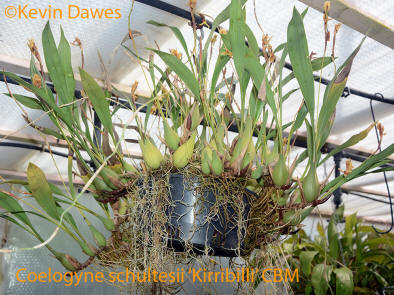This unusual species from Nepal, Burma, and China grows on tall rhododendrons and deciduous trees at altitudes up to 2000 metres but also on moss covered rocks. The deciduous trees indicate that it appreciates plenty of light in winter.
The flowering habit is a rare feature in Coelogynes. The spikes produce a cluster of small, rich caramel/honey coloured flowers and then the same spikes continue growing and produce next year's flower clusters.
My Coelogyne schultesii 'Kirribilli' CBM was granted an Award of Botanical Merit in 2012, hence the letters CBM and also the tag 'Kirribilli' to distinguish this particular plant from other examples of Coelogyne schultesii (however, I understand that all examples of this species in Australia have originated as divisions (cuttings) of a single plant in Queensland!.This award is granted, once only, to any species which is new and/or rare in cultivation in Australia and which has been cultivated well and is a good example of its type. The award is used as a bench-mark for future awards and judging of this species.
Growing Suggestions: Despite its cool background I would grow it in a shade house and protect it from any frost. Give it a good draining mix and water well in the warmer months. I have mine in a hanging basket so that the long flowering spikes can be seen clearly and not lost among other plants.
Negatives: Because the flower spikes should not be pruned (or you will lose many of next year's flowers) the plant becomes a bit whispy and need a lot of space. I would describe it as untidy.
Rating: ♦♦♦ This orchid is for collectors or anyone with plenty of room and an interest in unusual orchids.
Varieties: None known
Hybrids: None registered
| < Coel salvanerania | Coel sparsa > |
